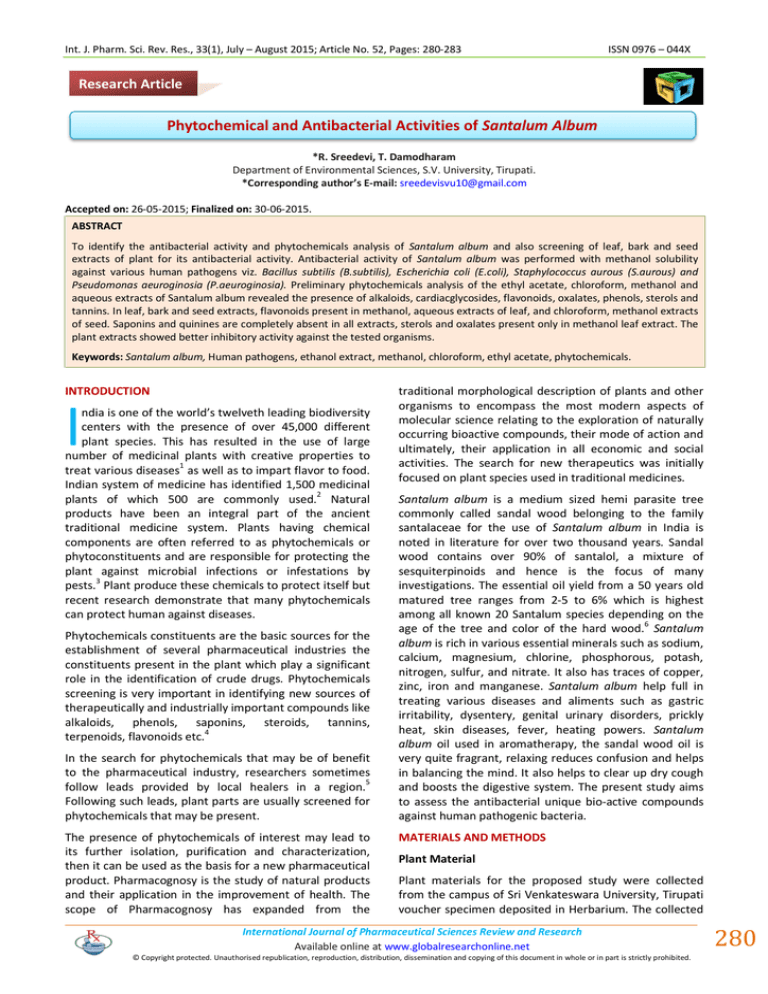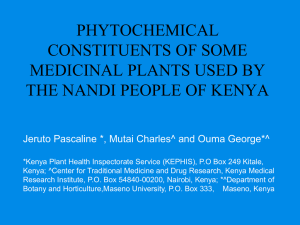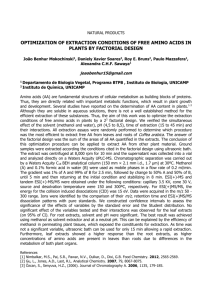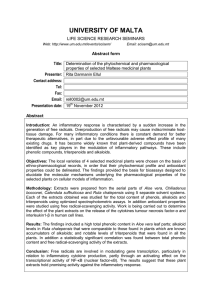Document 13310532
advertisement

Int. J. Pharm. Sci. Rev. Res., 33(1), July – August 2015; Article No. 52, Pages: 280-283 ISSN 0976 – 044X Research Article Phytochemical and Antibacterial Activities of Santalum Album *R. Sreedevi, T. Damodharam Department of Environmental Sciences, S.V. University, Tirupati. *Corresponding author’s E-mail: sreedevisvu10@gmail.com Accepted on: 26-05-2015; Finalized on: 30-06-2015. ABSTRACT To identify the antibacterial activity and phytochemicals analysis of Santalum album and also screening of leaf, bark and seed extracts of plant for its antibacterial activity. Antibacterial activity of Santalum album was performed with methanol solubility against various human pathogens viz. Bacillus subtilis (B.subtilis), Escherichia coli (E.coli), Staphylococcus aurous (S.aurous) and Pseudomonas aeuroginosia (P.aeuroginosia). Preliminary phytochemicals analysis of the ethyl acetate, chloroform, methanol and aqueous extracts of Santalum album revealed the presence of alkaloids, cardiacglycosides, flavonoids, oxalates, phenols, sterols and tannins. In leaf, bark and seed extracts, flavonoids present in methanol, aqueous extracts of leaf, and chloroform, methanol extracts of seed. Saponins and quinines are completely absent in all extracts, sterols and oxalates present only in methanol leaf extract. The plant extracts showed better inhibitory activity against the tested organisms. Keywords: Santalum album, Human pathogens, ethanol extract, methanol, chloroform, ethyl acetate, phytochemicals. INTRODUCTION I ndia is one of the world’s twelveth leading biodiversity centers with the presence of over 45,000 different plant species. This has resulted in the use of large number of medicinal plants with creative properties to treat various diseases1 as well as to impart flavor to food. Indian system of medicine has identified 1,500 medicinal plants of which 500 are commonly used.2 Natural products have been an integral part of the ancient traditional medicine system. Plants having chemical components are often referred to as phytochemicals or phytoconstituents and are responsible for protecting the plant against microbial infections or infestations by pests.3 Plant produce these chemicals to protect itself but recent research demonstrate that many phytochemicals can protect human against diseases. Phytochemicals constituents are the basic sources for the establishment of several pharmaceutical industries the constituents present in the plant which play a significant role in the identification of crude drugs. Phytochemicals screening is very important in identifying new sources of therapeutically and industrially important compounds like alkaloids, phenols, saponins, steroids, tannins, terpenoids, flavonoids etc.4 In the search for phytochemicals that may be of benefit to the pharmaceutical industry, researchers sometimes follow leads provided by local healers in a region.5 Following such leads, plant parts are usually screened for phytochemicals that may be present. The presence of phytochemicals of interest may lead to its further isolation, purification and characterization, then it can be used as the basis for a new pharmaceutical product. Pharmacognosy is the study of natural products and their application in the improvement of health. The scope of Pharmacognosy has expanded from the traditional morphological description of plants and other organisms to encompass the most modern aspects of molecular science relating to the exploration of naturally occurring bioactive compounds, their mode of action and ultimately, their application in all economic and social activities. The search for new therapeutics was initially focused on plant species used in traditional medicines. Santalum album is a medium sized hemi parasite tree commonly called sandal wood belonging to the family santalaceae for the use of Santalum album in India is noted in literature for over two thousand years. Sandal wood contains over 90% of santalol, a mixture of sesquiterpinoids and hence is the focus of many investigations. The essential oil yield from a 50 years old matured tree ranges from 2-5 to 6% which is highest among all known 20 Santalum species depending on the age of the tree and color of the hard wood.6 Santalum album is rich in various essential minerals such as sodium, calcium, magnesium, chlorine, phosphorous, potash, nitrogen, sulfur, and nitrate. It also has traces of copper, zinc, iron and manganese. Santalum album help full in treating various diseases and aliments such as gastric irritability, dysentery, genital urinary disorders, prickly heat, skin diseases, fever, heating powers. Santalum album oil used in aromatherapy, the sandal wood oil is very quite fragrant, relaxing reduces confusion and helps in balancing the mind. It also helps to clear up dry cough and boosts the digestive system. The present study aims to assess the antibacterial unique bio-active compounds against human pathogenic bacteria. MATERIALS AND METHODS Plant Material Plant materials for the proposed study were collected from the campus of Sri Venkateswara University, Tirupati voucher specimen deposited in Herbarium. The collected International Journal of Pharmaceutical Sciences Review and Research Available online at www.globalresearchonline.net © Copyright protected. Unauthorised republication, reproduction, distribution, dissemination and copying of this document in whole or in part is strictly prohibited. 280 © Copyright pro Int. J. Pharm. Sci. Rev. Res., 33(1), July – August 2015; Article No. 52, Pages: 280-283 plant material were transported in polythene bags and they washed separately under running tab water and distilled water for removing soil and other dust particles and finally washed with sterilized and de ionized water and the plant material were dried at room temperature. Extract Preparation Preparation of plant extracts were prepared by the method of Alade PI7with minor modification. 100 g of each powdered plant material were soaked in 100 ml of 70% alcohol for 72 h. and the mixture was stirred every 24 h using a sterile glass rod. At the end of extraction each extract was passed through Whatman filter paper No.1 (Whatman,UK) and The alcoholic filtrates obtained was concentrated in vacuous at 30°C and stored at 4°C until further use. Preliminary Phytochemical Screening The stock solution was prepared from leaf and bark crude extracts and was dissolved in its own mother solvents. The obtained stock solutions was subjected to preliminary phytochemicals screening.8,9 Antibacterial Assay The following bacterial strains were used in this study viz., Bacillus subtilis (B.subtilis), Escherichia coli (E.coli), Staphylococcus aurous (S.aurous) and Pseudomonas aeuroginosia (P. aeuroginosia). Disc diffusion assay method was carried out by using standard protocol.10 Overnight bacterial culture (100µL) was spread over Muller Hinton Agar (Hi Media Laboratories private limited Mumbai, India) plates with a sterile glass L-rod. 100µL of the each extracts were applied to each filter paper disc What man No.1 (5mm dia) and allowed to dry before being placed on the agar plate. Each extract was tested in triplicate and plates were inoculated at 37°C for 24 hrs. After incubation, the diameter of inhibition zones was measured. RESULTS AND DISCUSSION The qualitative phytochemicals estimation were showed that the presence of alkaloids, carbohydrates, cardiacglycosides, flavonoids, oxalates, phenols, tannins are present in ethyl acetate, chloroform, methanol and aqueous extracts of leaf, bark and seed and absence of proteins and amino acids, quinons, saponins, are completely absent in all extracts. Terpenoids, flavonoids, are present in ethyl acetate and chloroform leaf extracts, sterols are present only in methanol leaf extracts completely absent in ethyl acetate, chloroform and aqueous extracts of leaf. Alkaloids, carbohydrates, cardiacglycosides, flavonoids, Proteins and amino acids, tannins were present in methanol bark extract but oxalates, phenols, quinons, saponins, sterols and terpenoids are absent as shown in Table 1. The results of the methanol leaf, bark and seed exhibited antibacterial activity against all the tested strain viz. Bacillus subtilis, Staphylococcusaureus, Pseudomonas ISSN 0976 – 044X aeruginosa and Escherichia coli as shown in Table 2. The zones of inhibitions were produced by methanol extracts against all the test organisms. The zones of inhibition were ranging from 4-8mm in diameter. The maximum zone of inhibitions (8mm) noted in 2% methanol leaf extract against P.aeuroginosa and minimum zone of inhibition (4mm) was observed in staphylococci. The results of the antibacterial activity suggested that, the zone of inhibition of Santalum album was observed in leaf, bark and seed methanol extract against B.subtilis, S.aureus, P. aeuroginosia, E.coli and minimum zone of inhibition was observed in 2% and 5% concentrations of Santalum album leaf extract against S.aureus additionally B.subtilis, maximum zone of inhibition was observed in both P.aeuroginosa and E.coli in 2% methanolic leaf extracts compared to 2% methanolic bark extract as shown in Table 2. Maximum zone of inhibition was observed in 5% methanol extract in P.aeuroginosa, minimum zone of inhibition was observed in Santalum album methanolic seed extract at a concentration of 2% and 5% was not showing zone of inhibition against the organisms [Table 2]. The world health organization (WHO) with the increase in the incidence of resistance to antibiotics, alternative natural products of plants could be of interest. Some plant extract and phytochemicals constituents in the plant sample are known to be biologically active compounds and they are responsible for different activities such as antioxidant, antimicrobial, antifungal and anticancer.11,12 All secondary metabolite components displayed antibacterial properties through different biological mechanisms. Most of the secondary metabolite components were isolated and identified in the polar plant extracts.13 The biochemical screening of methanol crude extracts of Santalum album used in this study revealed that the crude extracts contained alkaloids, flavonoids, saponins and tannins (Table 1). The most effective bioactive compounds alkaloids and flavonoids were found in both methanol leaf and bark extracts. Tannins are another active compounds found to be present in both leaf and bark extracts, therefore, the detected different bioactive compounds in different crude extracts from leaf and bark extracts of Santalum album may be responsible for antibacterial activities several reports are available on flavonoids groups which exhibited high potential biological activities such as antioxidant and anti-inflammatory, anti-microbial, antianalgesic, anti-cancer and anti-allergic reactions.14-17 The antimicrobial activity of the leaf and bark crude extracts was estimated using standard conventional methods against S.aureus, E.coli, P.aeuroginosa and B.subtilis. The methanol crude extracts of Santalum album and its fractions revealed comparatively small antibacterial potential against gram-positive and gram negative bacteria at the concentrations of 2% and 5% International Journal of Pharmaceutical Sciences Review and Research Available online at www.globalresearchonline.net © Copyright protected. Unauthorised republication, reproduction, distribution, dissemination and copying of this document in whole or in part is strictly prohibited. 281 © Copyright pro Int. J. Pharm. Sci. Rev. Res., 33(1), July – August 2015; Article No. 52, Pages: 280-283 ISSN 0976 – 044X with their respective zone of inhibition of 4-7 mm (Table 3). in the crude extract may be diluted or increased their concentrations by fractionation.14,18,16,20-22 Generally the antimicrobial activity of plant crude extracts depends on the dose and the type of bacterial strains employed. Also this anti bacterial actions could be related to their chemical components in the crude extracts.18-22 The bioactive compounds such as tannins and flavonoids components were present in the crude extracts. However these bio active compounds were inducing the antibacterial activity. The amount of active components Because they have the ability to inactivate microbial activity, enzymes, cell envelope transport proteins and so 18-22 forth. Hence the presently studied Santalum album plant extracts could be of considerable infers to the development of new life saving drugs. However further research is required to isolate the bioactive principle of this species as well as further studies on its bio-efficiency against human pathogens. Table 1: Analysis of phytochemicals in Aqueous, methanol, ethyl acetate, chloroform Leaf Extract S.No Phytochemicals Bark Extract Ethyl acetate Chloroform Methanol Seed Extract Aqueous Ethyl acetate Chloroform Methanol Aqueous Ethyl acetate Chloroform Methanol Aqueous 1 Alkaloids + + + + + + + + + + + + 2 Cardiac glycosides + + + + + - + + - - + - 3 Carbohydrates + + + + + + + + + + + - 4 Flavonoids + - + + - - - - - + + - 5 Oxalates - - + - - - - - - - - - 6 Phenols + + + + - - - - - - - - 7 Phlobatanins + - - + + - + + - - - - - - - - + - + - - - - - 8 Proteins and Amino acids 9 Quinines - - - - - - - - - - - - 10 Saponins - - - - - - - - - - - - 11 Sterols - - + - - - - - - - - - 12 Tannins + + + + + + + + - - - - 13 Terpenoids + + - - + + + - - + + - + = high presence of bio active compounds , -- = absence of bioactive compounds. Table 2: Antibacterial activity o f methanol extract of Santalum album Diameter of zone of inhibition (mm) Leaf Bacterial strains Bark Seed 2% 5% 2% 5% 2% 5% P.aeuroginosia 8 5 5 6 0 0 S.aureus 4 4 4 4 0 0 E.coli 5 6 4 5 0 0 B.subtilis 4 5 5 5 0 0 CONCLUSION The present antimicrobial study of different crude extracts of Santalum album that the methanol crude extract from leaf and bark extracts shows highest activity against the employed bacteria and no activity was observed in seed methanol crude extract. Phytochemicals screening showed that the antibacterial activities of the crude extracts of Santalum album depends on the presence of phytochemicals such as alkaloids, steroids, flavonoids and tannins. The plant crude extracts could serve as potential sources of new antimicrobial activity. Further research is needed towards isolation and identification of active principles present in the extracts which could be used for pharmaceuticals. Acknowledgement: The authors R.Sreedevi express great full thanks to DST (INSPIRE) Department of Science and Technology, New Delhi for providing financial assistance as DST Inspire JRF. REFERENCES 1. Verpoorte R, chemo diversity and biological role of secondary metabolites, some thoughts for selecting plant material for drug development proc phytochemical soc Europe, Kluwer publishers, 43, 1998, 11-24. 2. Agrawal OP, Raju PS, Global market of herbal products: Opportunities for Indian traditional system of medicine, New Delhi, India, Narcosa publishing house, 2006, 5-10. 3. Abo KA, Ogunleye VO & Ashidi JS Antimicrobial potential of spondias mombin, croton zambesicus and zygotritonia crocea journal of pharmacological research, 5(13), 1991, 494-497. International Journal of Pharmaceutical Sciences Review and Research Available online at www.globalresearchonline.net © Copyright protected. Unauthorised republication, reproduction, distribution, dissemination and copying of this document in whole or in part is strictly prohibited. 282 © Copyright pro Int. J. Pharm. Sci. Rev. Res., 33(1), July – August 2015; Article No. 52, Pages: 280-283 ISSN 0976 – 044X 4. Liu RH 2004, Potential synergy of phytochemicals in cancer prevention: mechanism of action, Journal of Nutrition, 134(12 suppl), 2004, 3479S-3485S. aqueous and methanol stem extracts of Costus afer Ker Gawl. (Costaceae), African Journal of Biotechnology, 9(31), 2010, 4880-4884. 5. Nweze EL, Okafor JL & Njokuo. Antimicrobial activities of methanolic extracts of trumeguinees is (scchumn and thorn) and morinda Lucinda used in Nigerian Herbal medicinal practice, Journal of biological research and biotechnology, 2(1), 2004, 34-46. 15. Chao PDL, Hsiu SL, Hou YC, Flavonoids in herbs: biological fates and potential interactions with xenobiotics, Journal of Food Drug Analysis, 10(4), 2002, 219-228. 6. Sankarnarayana K H and Kamala B S perfume and flavor, 14, 1989, 19. 7. Alade PI, Irobi ON, Antimicrobial activities of crude leaf extracts of Acalypha wilkensian, Journal of Ethno pharmacology, 39, 1993, 171–174. 8. Harborne JB, Phytochemical methods. A guide to modern rd techniques of plant analysis 3 Ed., Chapman and Hall Int. Ed., New York, 1998. 9. Kokate CK, Pharmacognosy, 16th Ed, Niraliprakasan, Mumbai, India, 2001. 10. Anonymous. Pharmacopeia of India (The Indian pharmacopeia) 3rd Ed, Ministry of health and family welfare, Delhi, 1996. 11. Husain MA, Nagooru MR, Biochemical profiling and total flavonoids contents of leaves crude extract of endemic medicinal plant Corydyline terminals L, Kunth. Pahrmacognosy Journal, 3(24), 2011, 25-29. 12. Suresh SN, Nagarajan N, Preliminary phytochemical and antimicrobial activity analysis of Begonia malabarica Lam, Journal of Basic & Applied Biology, 3(1&2), 2009, 59-61. 13. Gonzalez-Guevara JL, Gonzalez-Lavaut JA, Pino-Rodriguez S, Garcia-Torres M, Carballo- Gonzalez M T, Echemendiaarana OA, Molina-Torres J, Prieto- Gonzalez S, Phytochemical screening and in vitro antitherapeutic activity of four Erythtroxylum species, Acta Farmaceut Bonaer, 23(4), 2004, 506-509. 14. Anyasor GN, Ogunwenmo KO, Oyelana OA, Akpofunure BE, Phytochemical constituents and antioxidant activities of 16. Igbinosa OO, Igbinosa EO, Aiyegoro OA, Antimicrobial activity and phytochemical screening of stem bark extracts from Jatropha curcas (Linn)., African Journal of Pharmacy and Pharmacology, 3(2), 2009, 058-062. 17. Thitilertdecha N, Teerawutgulrag A, Rakariyatham N, Antioxidant and antibacterial activities of Nephelium lappaceum L. extracts, Food Science and Technology, 41, 2008, 2029-2035. 18. Barile E, Bonanomi G, Antignani V, Zolfaghari B, Ebrahim Sajjadi S, Scala F, Lanzotti V, Phytochemical screening and antimicrobial assessment of Abutilon mauritianum, bacopa monifera and Datura Stramonium, Phytochemistry, 68, 2007, 596-603. 19. Ayoola GA, Coker HAB, Adesegun SA, Adepoju-Bello AA, Obaweya K, Ezennia EC, Atangbayila TO, Phytochemical screening and antioxidant activities of some selected medicinal plants used for malaria therapy in Southwestern Nigeria, Tropical Journal of Pharmaceutical Research, 7(3), 2008, 1019-1024. 20. Akharaiyi FC, Antibacterial phytochemical and antioxidant activities of Datura metal, International Journal of Pharmacology Technology Research, 3(1), 2011, 478-483. 21. Varahalarao V, Kaladhar DSVGK, Antimicrobial study of plant extracts of Datura metal L. against some important disease causing pathogens, Asian Pacific Journal of Tropical Disease, 2012, S94-S97. 22. Sekhar D, Kolanjinathan K, Saranraj P, Gajendiran K, Screening of Phyllanthus amarus, Acalypha indica and Datura metal for its antimicrobial activity against selected pathogens, International Journal of Pharmaceutical & Biological Archives, 3(5), 2012, 1231-1235. Source of Support: Nil, Conflict of Interest: None. International Journal of Pharmaceutical Sciences Review and Research Available online at www.globalresearchonline.net © Copyright protected. Unauthorised republication, reproduction, distribution, dissemination and copying of this document in whole or in part is strictly prohibited. 283 © Copyright pro







